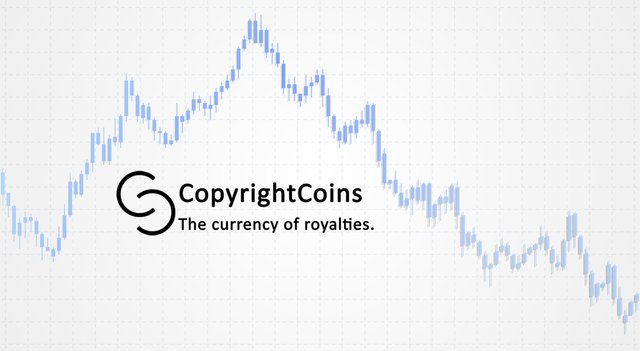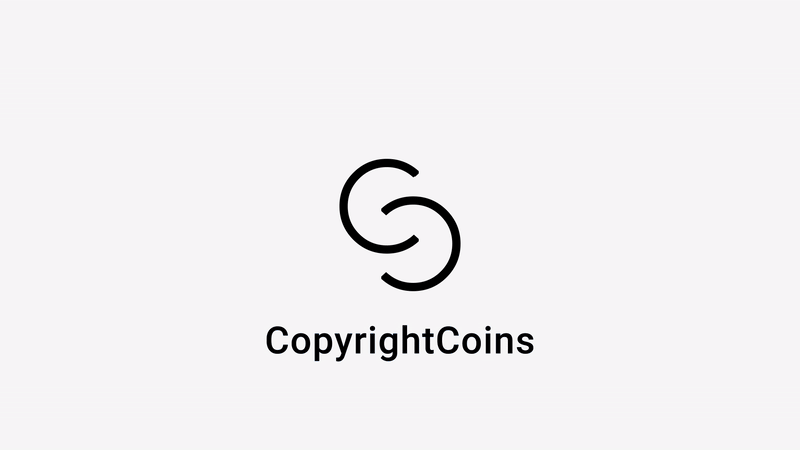CopyrightCoins is a stablecoin - and why is this important for "investors"?

In 2017 the Bundesbank completed the transfer of 300 tons of gold from the US to Germany. It took them four years to move the gold.
Gold has traditionally been an “asset” for investment when markets take a downturn. Other “safe havens” are US dollars, treasury bonds, defensive stocks, and currencies from stable countries, for example the Chinese yuan, the Japanese yen, and the Swiss franc.
Classic safe havens (except for gold) draw their strength from four qualities:
*Economic growth
*Strong country finances
*Stable political systems
*Liquidity (i.e., the ability to easily sell the asset without impacting the price of that asset)
So why is (for instance) the US dollar stable?
Two reasons:
*It is ubiquitous and used by many (millions) 24 hours a day. It’s a fact that short term stability is the essence of the US dollar.
*It’s under control by the Federal Reserve System. The Fed. can make new laws, buy back dollars and do everything necessary to maintain stability.
However, all “safe haven” assets have the same problems: accessibility, the cost of physical delivery, vulnerability to fraud.
Which is why we have seen an explosive interest in a new cryptocurrency asset – stablecoins!
A stablecoin is a cryptocurrency that is pegged to another asset (e.g. gold, the U.S. dollar, another cryptocurrency, etc.). A stablecoin should have the least volatility possible, as opposed to other cryptocurrencies that are often highly volatile in nature.
Stablecoins are a massive opportunity in the cryptocurrency market because they address such a large market.
The goal of a stablecoin is to become a digital form of fiat-free cash that is completely stable in value.
What are the criteria for a stablecoin?
A stablecoin must be a:
- A Medium of Exchange (MoE)
- A Store of Value (SoV)
- A Unit of Account (UoA)
a) Fungible,
b) easily divisible,
c)and easily moved
A medium of exchange,
It can be used to facilitate the sale of goods without the need to barter.
Aren’t all cryptocurrencies a medium of exchange? Basically yes, but most cryptocurrencies are not used to buy goods and services as they are lousy stores of value…
Stores of value.
A store of value will maintain the current value that it has without depreciating in the future.
January 2018 was a prime example why cryptocurrencies are not particularly useful as an actual form of money. Most cryptocurrencies have declined significantly in value from their all time highs (bitcoin lost 67% in 60 days). That means that most cryptocurrencies are useful for investing and speculation purposes not stores of value…
If an online store accepts cryptocurrency as payment it must exchange it into a stable currency within a short period of time . Also the exchange often involves large transaction fees due to the volatility.
Units of account
Cryptocurrencies are easily divisible to up to 18 decimal places (to get an exact amount of USD to 18 decimal places is ridiculous). Getting an exact amount of a stablecoin to 18 decimals is easy. CopyrightCoins (CCIM) have 18 decimal places, i.e. 100 million units (aka Thorbits) in 1 CopyrightCoin.
All cryptocurrencies can provide a unit of measurement to define and compare value. In the world of content licencing, CopyrightCoins has introduced Thorbits as a measure of nano-payment.
If you listen to a stream of music (3.5 minutes) the DSP (Digital Service Provider i.e. Spotify, Netflix, Computerworld, Apple Music et al) that serves you the content pays (for instance) 217 Thorbits for licensing a music stream once, – identified by CopyrightID (blockchain equivalent of ISWC and ISRC and in perfect harmony)
Another unit of account in the CopyrightChains is CopyrightShares that are created with the registration of a musical work or recording (or any content) identified by CopyrightID.
CopyrightShares are units of account that serves as a identifier for how many Thorbits (1/100000000 of CopyrightCoins) that will be paid in royalties for licensing 1 unit of content.
Or putting it simpler – 1 click = 1 licensing = 1 royalty payment.

A stablecoin (still using CopyrightCoins as an example) must be used as payment for goods and services (i.e. licensing) and exchangeable everywhere.
Consider the following scenario:
There are 3 main entities in the CopyrightCoins ecosystem
The “central bank” IMCA
CopyrightCoins are under the governance of IMCA (Internet Media Copyright Association – “not-for-profit”). IMCA has issued 25 billion CopyrightCoins (CCIM) and 24 billion are in escrow and not available in the market until certain conditions are met. i.e. certain thresholds of royalty payments flowing through the ecosystem. The release will be done in batches of 100 million per release, always in a predictable manner and over a 3 month period (see https://imcassociation.com for more info). 1 billion are released during the ICO/Crowdsale whereas 700 million are flagged for advances to Copyright Owners and as such will never leave the IMCA ecosystem.
The Content/Copyright Owners
To acquire exclusive online administration rights for content, Internet Music is putting advances back on the table. The IMCA has issued 24.7 billion CCIM that is ringfenced for paying advances to Copyright Owners. With 700 million already available (50 million CCIM is already in the process of being paid as an advance to a major music catalogue for a 3-10 year (TBD) exclusive administration contract).
Advances will be offered according to the level of security in the royalty flow created by the content , Just like the old days, the more popular the content the faster the advance is recouped.
For instance, a high-performance catalogue might be producing an average streaming revenue of 5m Euro per annum over ten years. IMCA might in this case, offer an advance of 50m CopyrightCoins to secure exclusive administration. Of course, in the context of Internet music’s promise of “MORE MONEY FASTER”, recoupment is likely to take place much faster than the ten year period covered by the advance.
THIS IS A NO-BRAINER – NOT A GAMBLE

Notwithstanding that CCIM is a stable cryptocurrency, It will be subject to rises and falls in exchange-rate-value as the public market dictates. However, Copyright owners and creators who assign their online rights to Internet Music in exchange for CopyrightCoins will always enjoy a minimum exchange rate guarantee of 1:1 parity CCIM/Euros
Should the Market exchange rate for CCIM exceed the guaranteed minimum, recoupment can take place even faster or the copyright owner can take a profit on the CCIM advance paid. Normally this administration can be done through Internet Music ltd.
The Digital Service Providers (DSPs)
A DSP must pay for licenses in CopyrightCoins (CCIM), CopyrightCoins must be bought for fiat at IMCA (Internet Media Copyright Association – the CCIM central “Bank”).
For each license paid an immediate transfer of CCIM will take place due to the nano-payment service. This transfer will take place entirely within the IMCA, from one wallet (“bank” account) to another.
If advances have been paid, the transfer will be done to a special escrow account (a multi-signature wallet account) if no advances have been paid – directly to the copyright owner’s wallet.
It’s highly likely that the DSP will want to charge their subscribers in CopyrightCoins (CCIM) for the content (i.e. monthly subscription etc) as to get the tokens needed to make the nano-payments for licensing.
Which all means a very high degree of fungibility, highly divisible and extremely easily moved between accounts.
Why is CopyrightCoins important for cryptocurrencies?
There are several reasons:
It is important to have a digital currency that remains stable in value (as opposed to Bitcoin, Ethereum, etc. that can be very volatile), like well-known currencies that remain relatively stable in value (such as the Euro).
CopyrightCoins fulfil the “store of value” requirement of money — something that even real-world currencies can’t say.
CopyrightCoins are backed by a real-world assets that are more valuable to the digital world today, creativity in content that fuels the Internet.
Internet is built on the backbone of content, but content owners rarely get paid for their creativity. And if they do (as in Musical Works) it can take up to 3 years to get paid (very little).
It’s controlled and administrated by a “not-for-profit” association Internet Media Copyright Association (IMCA) based in Estonia.
The Estonian finance inspection has accepted that CopyrightCoins is not a security and the Exchange in CCIM is not deemed as a payment service.
98.79% of the CopyrightCoins will ONLY be available to Copyright Owners and as such stay in the ecosystem as part of the advance lifecycle to the benefit of creators.
Transaction fees are low (between 0.9 and 2%) and beats most other cryptocurrencies (Bitcoin transaction fees are not suited for scalability) and definitely bank and transfer fees in “traditionally” payment solution (mainly due to no chargeback fees as in Visa and Mastercard).
Due to multicurrency wallets, transaction can take place in 100% privacy. However, that will influence the transaction fees as 3rd party fees are in additional to CopyrightCoins fees.
CopyrightCoins is the perfect vehicle for institutional and long-term investors and as such regulates the exchanges trading in CopyrightCoins.
It’s not easy to create a stable currency (especially a digital one). If a global, digital stablecoin were to be successful it would be able to solve many problems in economically unstable environment like the Internet.
When successful – CopyrightCoins will make a benchmark difficult to beat…
The potential for CopyrightCoins could be ginormous — on the low end, multi-billion dollar market cap, and on the high end, trillions (New Internet Media (NIM) the company behind the technology of CopyrightChains estimates the total royalties markets for content in the Internet – including video, design, music, articles, pictures, gaming and User generate content (UGC) in the trillions).
Stability in the cryptocurrency market is going to be a key investment criterion over the next years and as such, CopyrightCoins has a nice potential.
The CopyrightCoins “investment” potential.
Most crypto analysts and investors still haven’t seen (or won’t see) the funds cycle in the market. There are many reports of big investments in ICO’s and the ICOs eventually dump large amounts of BTC and ETH to the market. However, there are almost no reports of those funds being bought again by investors who then fund other ICOs with BTC and ETH.
New capital was not injected to new tokens; existing players in the crypto market used their crypto holdings to invest in ICOs.
Throughout 2017, ICOs demonstrated a 46 percent failure rate and if projects that fade away due to lack of community support and capital are also considered, the failure rate is closer to 59 percent.
To succeed with an ICO investment one must pick the ones with a clear focus on best business and legal practice, investor relations and fundraising.
Therefore, New Internet Media (aka NIM – the holding company behind the technology fuelling CopyrightCoins) is focusing on a combination of Venture Capital and ICO financing called ETO* in September 2018 and are NOT using any of the CopyrightCoins to finance growth and expansion as it’s common practice in an ICO.
The NIM business model is clear, everything in the ecosystem is to the benefit of Copyright Owners and created for one purpose only – to make more money, faster to the Copyright Owners.
The profit is from one simple task, transaction fee on making sure the DSP’s are paying the correct amount to the correct CopyrightShares owner. The whole commercial business model is one of finTech.
Transaction fee on royalties includes reporting and the level of transparency the Copyright owners wants.
*EQUITY TOKEN OFFERING (ETO) is a novel way of fundraising, which allows any kind of company (blockchain-based or not) to issue equity tokens on the Blockchain, in a public or private placement. Equity Tokens guarantee crucial equity-like rights for the investors and the issuers. Legally, Neufund’s Equity Tokens are securities structured as Vermögensanlagen (“Investment Assets”). The offering is subject to the German Banking Act (KWG) and the Investment Asset Act (VermAnlG).
✅ @internetmusic, I gave you an upvote on your post! Please give me a follow and I will give you a follow in return and possible future votes!
Thank you in advance!
upvote for me please? https://steemit.com/news/@bible.com/2sysip